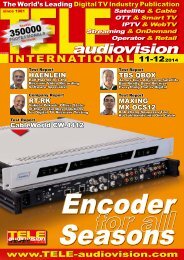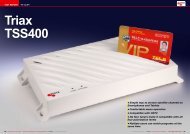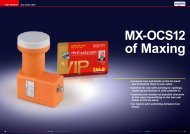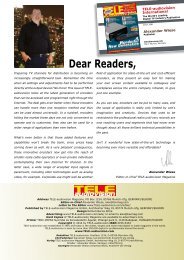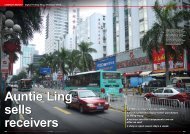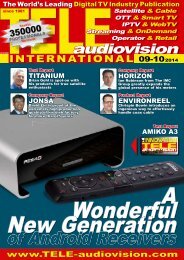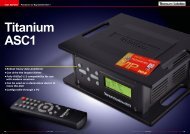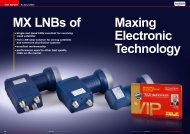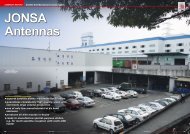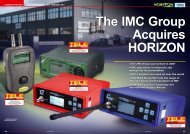eng TELE-audiovision 1307
The World’s Largest Digital TV Trade Magazine
The World’s Largest Digital TV Trade Magazine
Create successful ePaper yourself
Turn your PDF publications into a flip-book with our unique Google optimized e-Paper software.
The description reveals<br />
also additional functions of<br />
the SUS 21 F: possibility to<br />
include terrestrial signal in<br />
one of the satellite input and<br />
possibility to power it from<br />
an external optional power<br />
supply unit. Normally, the<br />
SCR is powered by the receivers<br />
connected to its output<br />
and no optional PSU is<br />
needed at all.<br />
The SUS 21 F has one multicolor<br />
LED indicator showing<br />
device status and error conditions.<br />
If the supply voltage<br />
from a receiver is too low or<br />
too high, you will know it.<br />
You will also be notified if a<br />
short circuit is detected in<br />
the output cable.<br />
We used our 85 cm offset<br />
dish for Ku-Band with a Twin<br />
LNB aimed at EUTELSAT16A<br />
on 16° East. Because this<br />
satellite had low and high<br />
symbol rate transponders,<br />
we were able to push the<br />
SUS 21 F to the limit. To<br />
make the test even harder,<br />
we used a 50 meter long coaxial<br />
cable (about 13 dB attenuation)<br />
and a flat cable<br />
window coupler (another 2<br />
dB attenuation). We started<br />
our test with observing the<br />
output signal of the SCR<br />
on the spectrum analyzer<br />
screen. It looked perfect.<br />
Except for the modulated<br />
carriers on 1076 MHz and<br />
1178 MHz there was nothing<br />
else. Carrier to noise ratio<br />
was in excess of 30 dB!<br />
After such successful beginning,<br />
we decided to first<br />
measure the signals routed<br />
directly from the Twin LNB<br />
(we marked them as REF<br />
1 and REF2) and then connect<br />
the SUS 21 F to the<br />
LNB and measure the signals<br />
available at its output (Slot<br />
1 and Slot 2) on 1076 MHz<br />
and 1178 MHz. As expected,<br />
the channel power (signal<br />
str<strong>eng</strong>th) varied significantly<br />
when the signal was taken<br />
directly from the LNB and<br />
was almost constant for every<br />
transponder when single<br />
cable router was used. The<br />
Automatic Gain Control circuit<br />
of SUS 21 F did its job<br />
very well indeed.<br />
The second important parameter,<br />
Modulation Error<br />
Ratio, that we used in our<br />
comparison is directly correlated<br />
to signal quality. The<br />
greater the MER, the better<br />
signal quality and greater<br />
margin for poor weather<br />
conditions. Taking into account<br />
that the SUS 21 F has<br />
to convert the signal from<br />
its “normal” position in Lband<br />
either to 1076 MHz or<br />
to 1178 MHz, we expected<br />
that we would notice a significant<br />
degradation of MER<br />
because every conversion<br />
always introduces additional<br />
noise. But, no! For the majority<br />
of transponders there<br />
was no difference at all. Only<br />
for the DVB-S2 transponders<br />
broadcasting with the highest<br />
symbol rate (30 Ms/sec)<br />
we observed slightly worse<br />
performance. For the most<br />
popular 27.5 Ms/sec transponders,<br />
the MER was unaffected.<br />
On the other extreme, at<br />
the lowest symbol rates (2.5<br />
72 <strong>TELE</strong>-<strong>audiovision</strong> International — The World‘s Largest Digital TV Trade Magazine — 07-08/2013 — www.<strong>TELE</strong>-<strong>audiovision</strong>.com<br />
Ms/sec), the SUS 21 F performed<br />
brilliantly. We noticed<br />
no difference in MER<br />
between LNB output and single<br />
cable router output.<br />
The test would not be<br />
complete if we did not try to<br />
connect a real receiver and<br />
zap channels. Every transponder<br />
and every channel<br />
that our receiver was able to<br />
process when connected to a<br />
regular LNB was also available<br />
in the single cable network<br />
even though we used a<br />
subscriber socket introducing<br />
extra 14 dB attenuation.<br />
Transponders with very low<br />
and very high symbol rates<br />
(2.5 through 30 Ms/sec)<br />
were available without any<br />
problem.<br />
It is worth knowing that<br />
channel zapping speed can<br />
be affected in a single cable<br />
network because when you<br />
change a channel from one<br />
transponder to another, a lo-




